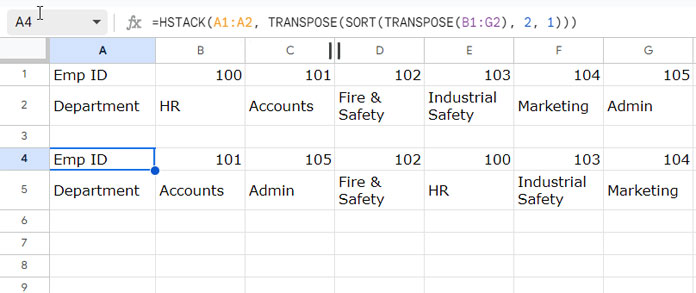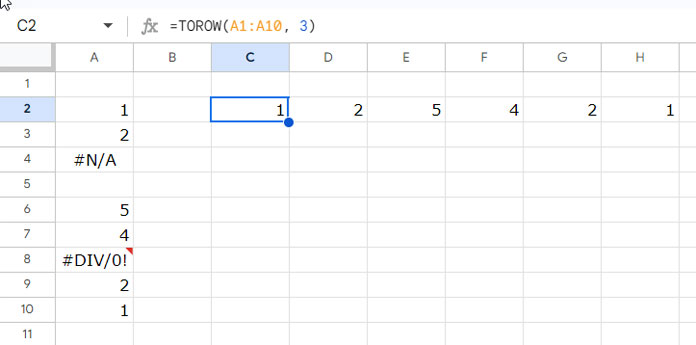Data manipulation and analysis are integral parts of any business or project. And when it comes to organizing and analyzing data in Google Sheets, the TRANSPOSE function is a powerful tool that can make your life a whole lot easier.
What is the TRANSPOSE function?
The TRANSPOSE function in Google Sheets allows you to swap rows and columns effortlessly. But did you know that there are other methods to achieve this as well? Let’s explore the different options:
- Transpose command: Similar to TRANSPOSE, this option offers enhanced control through copy-paste options.
- TOCOL and TOROW functions: These functions convert specific rows or columns into new columns or rows, respectively.
Each approach has its own strengths and weaknesses, making them suitable for different situations. In this tutorial, we will focus on the TRANSPOSE function to explore its capabilities in depth, while also briefly touching upon the other methods for a complete understanding.
TRANSPOSE Function: Syntax, Arguments, and Key Use Cases
The syntax of the TRANSPOSE function is quite simple:
TRANSPOSE(array_or_range)Here, array_or_range refers to the array or range of cells containing the data you want to transpose. This can be a single cell, a range of cells, or even a named range.
When you alter the data orientation from rows to columns or vice versa using TRANSPOSE, the following visual changes occur: The nth column becomes the nth row, and the nth row becomes the nth column. Applying TRANSPOSE twice maintains the original orientation.
The TRANSPOSE function can be used for various purposes, such as:
- Data manipulation: Transposing data can help rearrange your data for easier analysis, such as filtering rows by column values or vice versa. It allows you to work with your data on a different axis.
- Data presentation: It provides flexibility in how data is presented, making it easier to create charts or Pivot Table reports.
- Formatting QUERY Pivot headers: This is a more advanced tip for QUERY users. If your QUERY Pivot data has dates in the top row and you want to format them as Month, Year-Month, or Year, you can use TRANSPOSE along with other techniques to achieve this.
Example of TRANSPOSE Function in Google Sheets and Comparison with the Transpose Command
To give you a better idea of how the TRANSPOSE function works, let’s look at an example.
Suppose you have data arranged in columns, as shown below:

To change the orientation from columns to rows, you can use either the TRANSPOSE function or the “Transpose” command in Google Sheets.
To use the TRANSPOSE formula, if the initial data is in the cell range A1:G2, you can use the following formula:
=TRANSPOSE(A1:G2)Alternatively, you can use the Transpose command by following these steps:
- Copy the data in the range A1:G2.
- Right-click on any cell outside the range of A1:G2 to open the context menu.
- Select “Paste Special” > “Transposed”.
Additionally, there are keyboard shortcuts available for both Windows and Mac users to perform the transposition.
Choosing between the TRANSPOSE function and the Transpose command depends on your specific needs. Here are some factors to consider:
-
TRANSPOSE Function:
- Source Update: Changes in the source array are reflected in the transposed array.
- Formatting: This does not retain formatting from the source data.
- Editing: The result cannot be directly edited; the formula will break.
-
Transpose Command:
- Source Update: Updates in the source array won’t be reflected in the transposed data.
- Cell Formatting: Preserves formatting, including cell color, bold, italics, etc.
- Editing: The transposed data can be directly edited without affecting the source.
Nesting TRANSPOSE Functions
In Google Sheets, it’s common to transpose data, perform manipulations, and then transpose again. However, when doing this, it’s crucial to avoid transposing the initial column or row containing labels.
Let’s say we want to sort the data in A1:G2 by departments using the SORT function. Since we can sort data by columns, not by rows, and the department data is in the second row, we need to transpose the range B1:G2, perform sorting, and then transpose it back.
In addition to that, you can use the HSTACK function to join the labels in the original table with the new table.
The formula would look like this:
=HSTACK(A1:A2, TRANSPOSE(SORT(TRANSPOSE(B1:G2), 2, 1)))Here’s an example of how this nested TRANSPOSE formula would look:

TOCOL and TOROW: Alternatives for Single-Row/Column Transposition in Google Sheets
While the TRANSPOSE function is a versatile tool for swapping rows and columns, there are alternatives available for dealing with single-row or single-column data. These alternatives are the TOCOL and TOROW functions.
In the transposition perspective, you can use these functions with a single column or row, as they are originally designed to transform an array or range of cells into a single column or row.
These functions can ignore blank cells and errors, making them ideal for cleaning data before further analysis. Here’s how they work:
- TOCOL: Use it to transform one-dimensional horizontal data into vertical data.
- TOROW: Use it to transform one-dimensional vertical data into horizontal data.
For example, suppose you have data in A1:A10 with blanks and errors. You can experiment with the following formulas to alter the orientation:
=TOROW(A1:A10, 3)This formula creates a new row, skipping blanks and errors.

=TRANSPOSE(A1:A10)This formula creates a new row with all data, including blanks and errors, which might not be desirable.
Additional Tips
Here are some additional tips to enhance your understanding and usage of the TRANSPOSE function in Google Sheets:
-
The TRANSPOSE function typically doesn’t require ARRAYFORMULA support. However, in some cases, when you’re using an expression within the TRANSPOSE function rather than a physical range, you may need to include ARRAYFORMULA to expand the expression.
-
Always double-check your formulas and ensure that the source range exists in the expected location to avoid the #REF! error.
-
If you receive the #N/A error, it means that TRANSPOSE received more than one range as input. Make sure your formula references only one range and consider using nested functions or other approaches if you need to combine data from multiple ranges.
I hope the information provided in this article helps you leverage the TRANSPOSE function effectively in Google Sheets. For more tips and tricks on Google Sheets and other Google tools, visit Crawlan.com.
Remember, with the TRANSPOSE function in your toolbox, you can effortlessly transform your data and unlock new insights for your business or project. Happy transposing!



